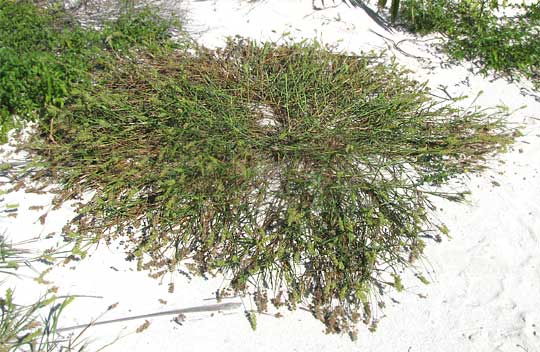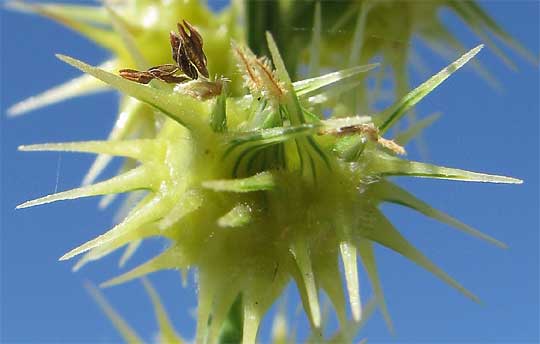Excerpts from Jim Conrad's
Naturalist Newsletter
from the December 8, 2008 Newsletter written at Mayan Beach Garden Resort 20 kms north of Mahahual; Caribbean coastal beach and mangroves, ~N18.89°, ~W87.64°, Quintana Roo state, MÉXICO
COASTAL SANDBUR
I have nothing but nice things to say about Goat's- Foot Morning-Glory, but I can't write some of the nasty thoughts I've had about the big, flat clumps of Coastal Sandbur that's also very common here, in the same ecological setting as the morning-glory. You can see a sprawling, six-ft-across Coastal Sandbur below:

That's CENCHRUS SPINIFEX, a real grass in the Grass Family, and what's so cussed about it is clearly shown below:

Those are grass flowers abundantly armored with stiff, very sharp spines which themselves are mantled with minute, backward-pointing spines. When a sandbur punctures your skin, because of those backward- pointing spines, pulling it out becomes a miserable experience. If you're not thinking, when you realize the bur is resisting being pulled out, you squeeze it harder to get a better grip, and end up with stuck fingers, and with those backward-pointing spines on the spines, there's simply no nice way of getting unstuck.
Though Coastal Sandbur is native American, even found in sandy soils throughout much of the US Southeast, it's invading other countries. A website in Ukraine says that in that area up to 300 plants can occupy a square meter, and that the species "...harms sheep farming, because prickly seeds cling to the sheep wool and sharply reduce its quality. When eaten by sheep, they damage mucosa and cause ulcers and tumors." That's not to mention what happens to barefoot beachwalkers here. Of course even this species provides a valuable service to the beach ecosystem, for its broad mats also stabilize the sand. I wouldn't be surprised if it also protects other plant species growing nearby by causing herbivores to steer clear of the whole area.
If you look closely at the above picture you'll see that the bur on the left is topped by dark brown, elongate male anthers, while the bur on the right is topped by pale, fuzzy, female stigmas. The spines below these flower parts arise from the flowers' involucre, or collection of bracts, or modified leaves, growing immediately below the two flowers.